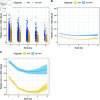Prognostic prediction of dengue hemorrhagic fever in pediatric patients with suspected dengue infection: A multi-site study
- PMID: 40758699
- PMCID: PMC12321061
- DOI: 10.1371/journal.pone.0327360
Prognostic prediction of dengue hemorrhagic fever in pediatric patients with suspected dengue infection: A multi-site study
Abstract
Dengue virus (DENV) infection is a major global health problem. While DENV infection rarely results in serious complications, the more severe illness dengue hemorrhagic fever (DHF) has a significant mortality rate due to the associated plasma leakage that may lead to hypovolemic shock. Proper care thus requires identifying patients with DHF among those with suspected dengue so that they can be provided with adequate and prompt fluid replacement. In this study we used seventeen years of pediatric patient data from a prospective cohort study in two hospitals in Thailand to develop models to predict DHF among patients with suspected dengue infection. We produced models for a general hospital setting and for a primary care unit setting lacking lab facilities. The best model using combined data from both hospitals achieved an AUC of 0.90 for the general hospital setting and 0.79 for the primary care unit setting. We then investigated the generalizability of the models by training models with data from one hospital and testing them with data from the other. For some models, we found a significant reduction in performance. Possible sources of this are differences in how attributes are defined or measured and differences in the hematological parameters of the two patient populations. We conclude that while high accuracy prediction of DHF is possible, care must be taken when applying DHF predictive models from one clinical setting to another.
Copyright: © 2025 Su Yin et al. This is an open access article distributed under the terms of the Creative Commons Attribution License, which permits unrestricted use, distribution, and reproduction in any medium, provided the original author and source are credited.
Conflict of interest statement
The authors have declared that no competing interests exist.
Figures




References
-
- Schaefer T, Panda P, Wolford R. Dengue Fever. Treasure Island (FL): StatPearls. 2019. - PubMed
-
- World Health Organization. Dengue haemorrhagic fever: diagnosis, treatment, prevention, and control. 1997.
-
- World Health Organization, Special Programme for Research and Training in Tropical Diseases, World Health Organization Department of Control of Neglected Tropical Diseases, World Health Organization Epidemic and Pandemic Alert. Dengue: guidelines for diagnosis, treatment, prevention and control. World Health Organization; 2009.
Publication types
MeSH terms
LinkOut - more resources
Full Text Sources
Medical
Miscellaneous

